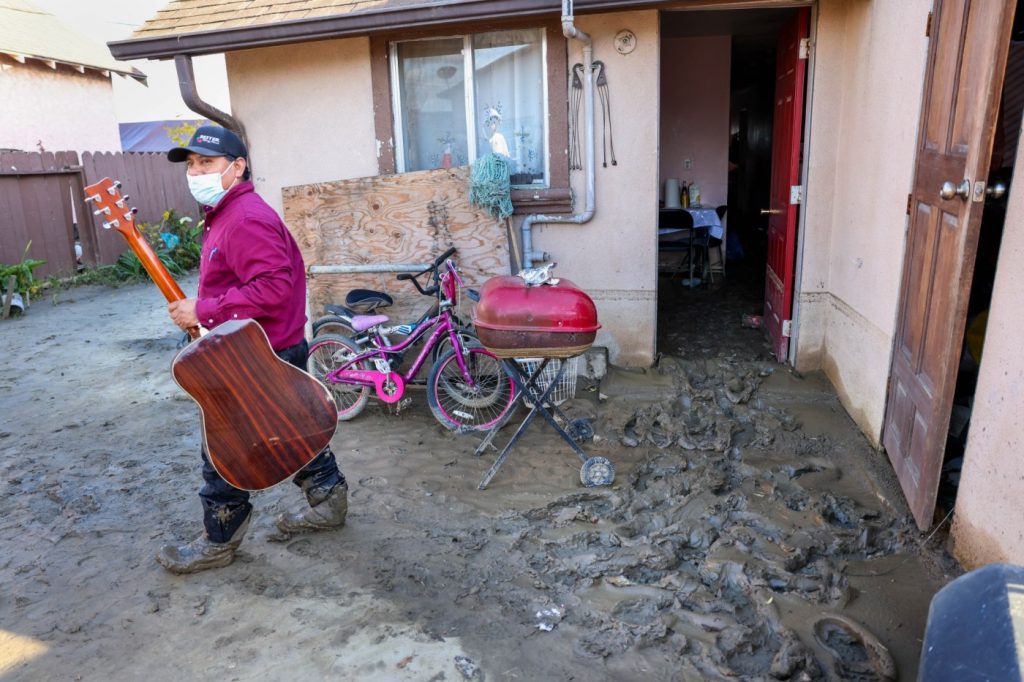By FELICIA MELLO | CalMatters
After flood waters from heavy rainstorms deluged two small farmworker towns in January 2023, California set aside $20 million each for the communities to rebuild.
Related Articles
Bay Area rain: Final totals show which areas got the most and least in the wettest storm of 2024
Map: See where it’s raining in the Bay Area
More rain in the forecast Monday and Tuesday
Weather reprieve on Sunday, after record-breaking Bay Area storm
Sierra Nevada ski resorts are open, but getting there will be ‘very difficult to impossible’
Nearly two years later, four-fifths of that aid has not yet been distributed to flood victims of Planada in Merced County, and even less has been distributed in Pajaro in Monterey County.
While county officials and non-profit workers say the slow pace stems from a deliberative planning process and state rules requiring verification of recipients’ residency and losses, a new atmospheric river soaking Northern California is causing anxiety for locals who saw their neighborhoods destroyed once before.
RELATED: From eucalyptus removal to prescribed burns, Monterey Bay area climate change projects launched
Days of rain in January of 2023 caused canals and creeks to overflow in the two communities, hitting many residents with a triple whammy: displaced from their homes, their possessions destroyed, their work hours in the field cut. State lawmakers granted the relief funds in the fall of 2023. The counties divided them into various pots to cover reimbursement for belongings and wages, home repair, business losses, and infrastructure improvements to prepare for the next storm.
As of this month, about $4 million of the $20 million in state aid designated for Planada had been spent, the bulk of that in direct payments to families, Merced County spokesperson Mike North said. In Pajaro, county officials working with nonprofits have handed out about $1.3 million of its $20 million share: $450,000 in grocery gift cards to residents whose food spoiled during the flooding, plus about another $800,000 to people and businesses with larger losses not covered by federal disaster aid or private insurance.
Angela DiNovella, the executive director of Catholic Charities Diocese of Monterey – one of two organizations contracted with Monterey County to help Pajaro residents apply for the funds – said her organization’s three case workers were distributing an average of $30,000 per week to families.
One of the main challenges, she said, was verifying eligibility for families who lacked a permanent address or lived in overcrowded conditions, such as when three families share a single apartment. Some people also struggled to document how much they had lost, so caseworkers were doing the painstaking labor of reviewing photographs and trying to estimate the dollar value of each item.
“The reality is this is state funding that comes with a lot of requirements,” she said. “Our work is to be creative with the families and be on their side but even that takes time.”
Monterey County set up an assistance center in a community park this past spring to help residents apply for the aid, DiNovella said. But Danielle Rivera, an environmental planning professor at UC Berkeley who conducts fieldwork in the area, said many community members remain confused about where the state aid is going and how to benefit. And some, she said, may have moved away before they got any help.
“People were displaced from the floods – they were renting and the landlord said ‘This unit’s out of commission.’ Then that household tries to find housing somewhere else and maybe they came back to Pajaro, maybe they went to Watsonville, maybe they just left the Pajaro Valley entirely,” she said.
Residents in both communities who were undocumented could also qualify for a statewide Storm Assistance for Immigrants program, aimed at helping California flood victims who were ineligible for federal emergency assistance. The $95 million statewide program for storm victims offered a flat stipend of $1,500 per qualifying adult.
Millions in additional aid from philanthropic groups, private insurance and the Federal Emergency Management Agency has also poured into Pajaro since the floods, county officials said — though residents’ ability to access that help varied based on whether they were homeowners or legal U.S. residents.
In Planada, North said the county had nearly completed distributing funds for replacement of lost vehicles, personal property and business assets, and was moving on to help with home repair. That work “takes more time as it’s dependent upon certain detailed inspections for issues like mold, foundation damage, asbestos testing, and could require structural engineering in some cases,” he said by email.
Infrastructure projects are also moving forward, North said, though more slowly. The county has replaced a backup generator for the local community services district that failed during the floods, and is commissioning a study on how to prevent future inundations.
Half of Pajaro’s $20 million is earmarked for infrastructure and emergency preparedness projects, and Monterey County spokesperson Nick Pasculli said the county had requested bids for about half the projects.
DiNovella, whose organization also worked with families displaced by the 2020 fires in the Santa Cruz Mountains, said that communities often take years to recover from disasters and that the pace of aid in Pajaro, while slow, is sadly par for the course. The most recent batch of aid, while delayed, will give families a boost during the slow winter season when many farmworkers are barely scraping by, she said.
One Pajaro resident who got state help is Jesús Padilla, who’s lived in the town for 25 years, working the strawberry and blackberry harvests. When the floods hit, he and his family just had time to grab the three children’s birth certificates and run. They lost everything – furniture, clothes, kitchenware.
Now, he worries most about his family’s physical and mental health. Every time it rains, his children ask him, “If it keeps raining more, where will we go?”
His family had already replaced many of their belongings, but the state grant that Catholic Charities helped him obtain reimbursed some of their expenses. He has friends who are still waiting for help.
He tells them to be patient – “It seems like the process is working. Just slowly.”
Much of the North Monterey County town of Pajaro, just across the Pajaro River from Watsonville, is submerged with flood water on Sunday after the river levee breached in March 2023. (Shmuel Thaler – Santa Cruz Sentinel file)


